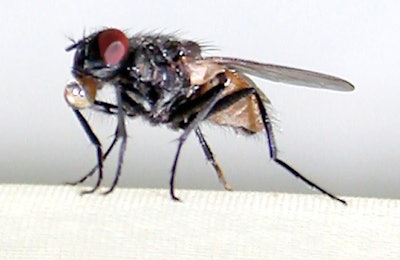
More evidence of the need to concentrate greater focus on transmission in the fight against antibiotic resistance has emerged with the publication of studies showing the role that flies may have in spreading antibiotic-resistant bacteria.
If you think that the humble fly has little to do with the spread of resistance, the studies’ authors conclude that flies' ability to contaminate the environment has led to “immense public health concerns.”
In one study, the researchers found that 1 percent of hospital patients in two large cities in China were carrying colistin-resistant bacteria, despite the antibiotic not being used in human medicine.
To date, China has reserved colistin for veterinary use, with some 8,000 metric tons used each year, primarily in pig and poultry production, reports New Scientist. A ban on its use in the livestock industry comes into force in China this month.
So if these city-dwelling patients did not become infected with colistin-resistant bacteria due to lax controls over the antibiotic in human medicine, how did they become infected?
The same research team from Cardiff University, UK, has also been looking at resistant bacteria beyond the confines of hospitals. They found a quarter of Escherischia coli bacteria sampled from chicken farms and from meat in grocery outlets was resistant to colistin, while a third was resistant to carbapenem.
But they also found high rates of bacteria with colistin- and carbapenam-resistant genes in dog feces on chicken farms and on flies at these farms, indicating that resistant bacteria have colonized beyond the farmed birds.
The Cardiff team argues that flies’ ability to contaminate the environment has immense public health concerns and that fly transmission may be why hospital patients living far away from farms were not less likely to have a resistant infection during the summer than those living nearby.
Coming from a farm not near you
But it's not only flies that may be spreading resistant bacteria. Wild birds, long associated with the spread of viral disease, may also be responsible for transmission.
Resistant bacteria were also found in feces from swallows on farms in China, raising fears that they will carry these bacteria as they migrate, and potentially spreading resistance much further afield.
Bacterial DNA sequences from the sampled poultry farms, slaughterhouses, supermarkets and people were so similar that colistin and carbapenem resistance must have spread first in the poultry sector and then to people, the researchers conclude.
In addition to looking at how resistant bacteria are spread, the team also discovered that far more bacteria are actually carrying the mrc-1 resistance, even if not using it, than previously thought.
Almost all the bacteria sampled on chicken farms had the mrc-1 gene, although only half resisted colistin, meaning that the potential for resistance may be greatly underestimated by standard tests.


















